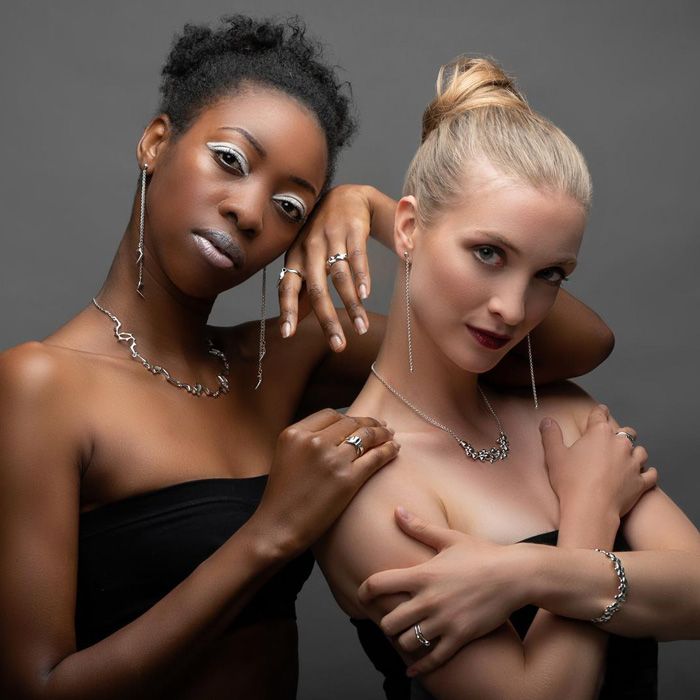Choosing the metal for your piece will of course depend on your taste and budget, but also on the piece itself. We have put together a little guide to help you make the right choice.
Silver
Pure silver or fine silver is too soft to be made into a piece of jewellery. The silver is alloyed with other metals in order to improve its hardness and durability.
Sterling silver is the most popular alloy, comprising 92.5% pure silver and 7.5% copper. Sterling silver will be hallmarked with a ‘925’ mark, which stands for 92.5% pure silver.

Advantage:
- Sterling silver is a relatively affordable material, but the price of a silver item will depend on the labour involved and the complexity of the design.
Inconvenience:
- Silver oxidises (tarnishes) when exposed to the oxygen in the air, subsequently causing the surface to turn black; therefore, it has to be cleaned on a regular basis.
- Silver is not as durable as gold or platinum, therefore we do not recommend choosing silver for jewellery such as wedding or engagement rings.
We use 100% recycled silver
Recycled silver comes from old jewellery, medical equipment, electronics or giftware and can be utilised to make items with the same quality results, with the added benefit of being more environmentally friendly. Also called Eco-silver, 100% recycled sterling is a green alternative to traditional sterling silver.
Gold
Like silver, gold is soft, and so in order to vary its colour and hardness, gold is alloyed to other metals. Native gold is yellow, but alloyed to silver, platinum or zinc will turn its colour white. Copper is added in order to obtain a red or pink gold, and iron for a tinge of blue.
The purity of the gold is indicated in terms of its carat, which defines the proportion of pure gold present in the metal. Pure gold is 24 carats; therefore, the purity of the gold is expressed in 24ths, meaning 18 carat gold is an alloy of 18 parts pure gold and 6 parts other metals. The purity of gold used in jewellery are 9 carat, 14 carat, 18 carat, 22 carat and 24 carat, the latter of which (pure gold) is rarely used to make jewellery pieces as it is too soft. The hallmark will represent the fineness of the metal in parts per thousand: 9 carat gold will be marked ‘375’, 14 carat ‘585’, 18 carat ‘750’, 22 carat ‘916’ and 24 carat ‘999’.
The price of gold will depend mainly on the purity of the metal as well as the labour and design of the piece.
NOTE: White gold contains native yellow gold alloyed with other metals, therefore, it will always have a yellowish hue.

Advantage:
- More durable than sterling silver, gold makes a great choice for wedding and engagement rings.
- Available in a range of colours.
Inconvenience:
- Standard gold mining is harmful to the environment and human health. Make sure you opt for a recycled or ethically sourced gold alternative.
We use 100% recycled gold
It is the green alternative to standard gold, made from recycled gold coming from old jewellery, medical equipment, electronics or giftware. Allowing for the same quality results this is a more environmentally friendly option.
We offer a jewellery remodelling service, so why not bring us your old gold jewellery and let us turn them into a new modern piece.
And Single Mine Origin gold (SMO) – ethical gold
Sourced from specific, ethically operated mines, SMO delivers unique vertical integration with an auditable chain of custody for the entire supply chain and full segregation from mine to finished product. SMO gold must adhere to a number of strict CSR guidelines, so it only originates from mines with a proven track record of committed social and environmental responsibility.
Platinum
Platinum is the rarest of the three precious metals—30 times rarer than gold and is the most durable precious metal. It is more resistant to corrosion and does not tarnish (like silver does). It is slightly more dense than pure gold and approximately twice as dense as silver. Like silver and gold, platinum is alloyed with other metals, and is usually 95% platinum with 5% other metal. Pure platinum is hallmarked ‘999’, and the 95% platinum is hallmarked ‘950’.

Advantage:
- Platinum is recognised as the strongest of jewellery metals, and does not require as much care as gold and silver.
- Very durable it is the perfect choice for wedding or engagement rings.
Inconvenience:
- Platinum is heftier than gold or silver and therefore it can be more expensive, although gold prices have raised in the recent years and are currently almost similar to the price of platinum.
We use 100% recycled platinum
Just like recycled silver or gold, 100% recycled platinum is a greener alternative.

